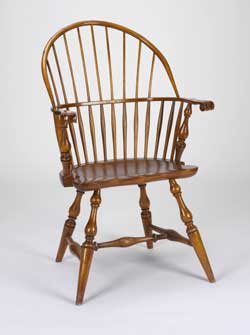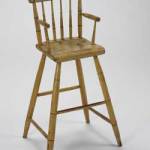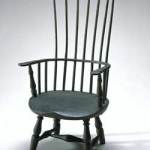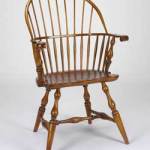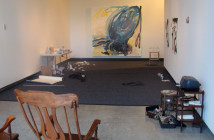Spindles and Spokes: Windsor Chairs and their Legacy in America, now on display at the RISD museum, is a show of one of the most prolifically produced chairs in the last two centuries. First appearing in England in the 1720s and shortly thereafter in America, these chairs have withstood the test of time and have continually served as a symbol for “dignified” and “honest” furniture making.
"Windsor" is the generic name for furniture with turned legs with back spindles doweled into a solid seat. This simple, yet effective, way to produce comfort has created a market for both high-end collectors and vintage furniture stores alike. To achieve such a broad aesthetic market the Windsor chair was faced with the prospect of surviving the important Arts and Craft movement. During this time, the humble design was subject to great debates on design and the role of function and beauty in objects.
One of the leaders during the period was the British designer and theorist John Ruskin. Central to this discussion is Ruskin’s insistence on a dignified and elevated look of the Decorative Arts. Writing in the late 19th century, Ruskin goes beyond simply trying to level out the implied schism between the Decorative Arts and other forms by stating that the greatest art ever produced was indeed decorative. For Ruskin the real difference between the Decorative Arts and other art lies in the object’s designation. To this end, all art achieves its best status when it is suited most accordingly to its function. He praises the frescoes of Titian for their fixed position in the architecture and criticizes “portable art” (defined as art independent of all place) as ignoble. Even the first-rate examples of “portable art” were seen by Ruskin as a “far more contemptible piece of work” than one subordinated to the purpose it has to serve for its particular place.
Ruskin proceeds to distinguish the orders and dignities of the Decorative Arts. The Windsor chair could be seen to occupy Ruskin’s second order. In this order, objects are made for areas that are more liable to injury -- to wear and tear. With its solid construction and relatively minimal carving and surface ornament the Windsor chair is made for use. Having relatively few embellishments the chair can thus take some abuse and still maintain its form and integrity. In short, the Windsor chair’s popularity over the centuries could be attributed to its seeming acknowledgement of its proper order and function.
Even though the Windsor does not carry a great amount of ornament, within some parameters, the chair does allow artisans to create some beautifully shaped wood. Perhaps the most attractive is the “Comb-Back Armchair" from Philadelphia. The idea of sitting in this imposing tall-backed and broad-crested chair could leave any viewer totally immersed in the furniture. Also of note are the continuous-arm chairs where a single piece of wood is bent to form both the arms and back-rails. This particular American innovation shows the subtle yet elegant innovations that have occurred within a standard form -- yet it is not too decorated or structurally weak to prevent normal use. Combining both elegance and stability within a relatively minimal design make this chair worthy of being in almost any traffic area in almost any house (where quality of wood and stain can match almost any surrounding to create a harmonious, yet functional arrangement).
Ironically, these examples of Windsor furniture do not feel at home in this gallery. Marked by wear and tear (as is any good piece of furniture) and clearly drained of any use-value, the pedestal-displayed chairs essentially mimic a graveyard. Out of their desired and appropriate surroundings, the distinctive features of each grouping (side chairs, writing desks, armchairs, and various other knickknacks including a footstool and spinning wheel) create a monotonous quality that makes the individual features seem arbitrary. In a sort of graveyard for once-used furniture, viewers will likely appreciate this display most when a chair resembling one from their own home is identified.
In this regard, the museum acts as the perfect graveyard for the utilitarian object, which simply cannot perform at an optimum level anymore -- yet is still worthy of display for the simple fact that it performed so well for so long. The museum display of chairs is thus like using the corpse as a grave marker -- it is pure matter standing for its previous active self. I prefer to see the Decorative Arts dispersed in the museum along with other things, re-creating (and thus reevaluating) their order and status as object. If presented in this way the dignity of the Windsor chair could live on for some time in its present deactivated self.
- American, Boston, Massachusetts, Windsor high chair, 1830-50. White pine, maple, birch, aspen and painted decoration. Museum of Art, Rhode Island School of Design, Museum Works of Art Fund. Photography by Erik Gould.
- American, New England, Child’s comb-back Windsor armchair, 1760-1800. Ash, maple and pine. Museum of Art, Rhode Island School of Design, Gift of Mrs. Henry Vaughan. Photography by Richard Cheek.
- American, A. H. Davenport/Irving and Casson, manufacturers, Sack-back Windsor armchair, ca. 1920. Pine, maple and oak. Museum of Art, Rhode Island School of Design. Gift of FleetBoston Financial.
Links:
Windsor Chair Resources
RISD Museum
"Spindles and Spokes: Windsor Chairs and their Legacy in America" is on display at the RISD Museum during February 20-April 25, 2004.
Micah J. Malone is a regular contributor to Big, Red and Shiny.

